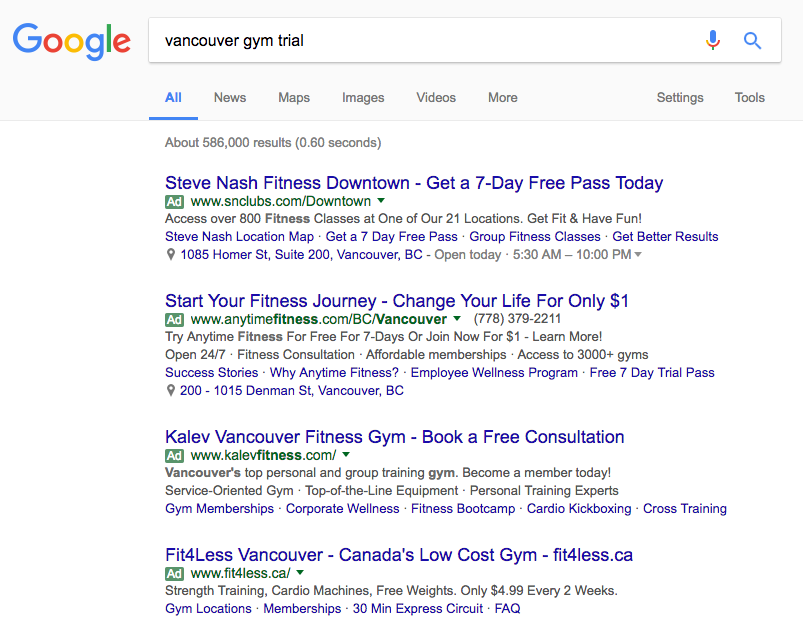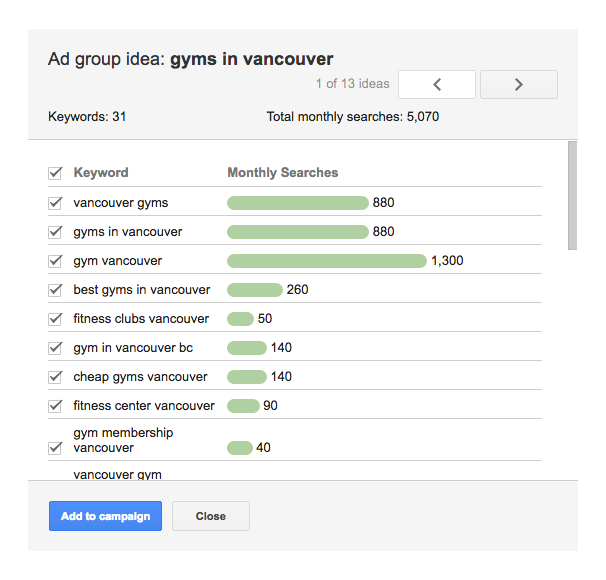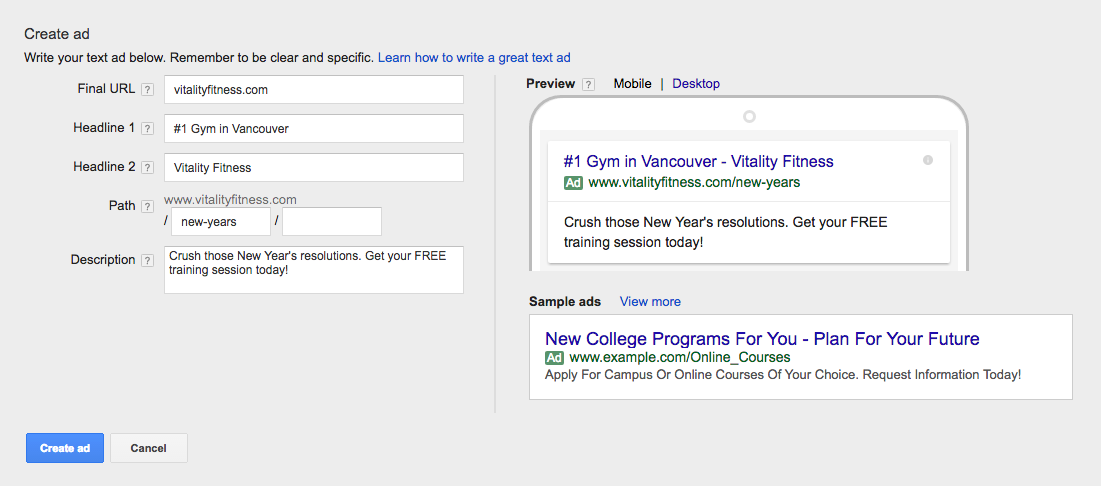[content-section top=”100″ bottom=”160″ classes=”main-content home-page”]
The Complete Guide to Google Ads for Fitness Centers
If you’ve ever used Google, there’s a pretty good chance you’ve seen Ads – they’re those little search results that come before the “real” results.
They also happen to be one of the most powerful tools you can use to drive traffic to your website.
Google Ads helps you connect your business to people who could be interested in it. Because (the all-powerful) Google has a wealth of data on its users and relies on search intent to serve ads, the impressions you receive with Ads are targeted and relevant.
In this guide, I’ll show you how to set up your first Ads campaign, with some best practices along the way so you can find success, drive traffic, and get more members for your fitness center.
Let’s get into it!
How Google Ads works
Just as in fitness, finding success on Google Ads requires a combination of effort and knowledge – but there’s no denying how effective it can be for your business
Google’s ads platform is based on an “auction” model. What does this mean? To create ads for Google, you need to identify keywords (or phrases) that your target market might search for, and bid on these keywords.
Though this might seem like a “pay-to-win” model, at the end of the day, Google’s goal is to help users find what they’re looking for. Thus, the most successful ads are those that combine a high bid with relevant content that answers users’ questions.
Google uses its (admittedly pretty terrifying) wizardry to serve ads based on a user’s search intent, geographic location, and search history, among other things.
What exactly is search intent? Let’s look at three examples and see how they differ in search intent…
Search 1: “gym” – This search has low intent – someone might just be searching for workout routines or general information about gyms. This means the cost to run ads on this keyword is relatively low, as people searching “gym” probably aren’t looking to join a gym. However, it will be a very high-volume keyword (ie a lot of people will be searching for it).
Search 2: “Vancouver gym” – Compared to the first search, someone searching for “Vancouver gym” has much higher intent. They’re looking to gather information or canvas fitness centers in Vancouver, which implies they could be looking to join a gym. As such, the bid for this keyword would be higher, as there might be multiple fitness centers in Vancouver looking to serve ads for it.
Search 3: “Vancouver gym trial” – This search has the highest intent of all three. It’s clear that this user is actively looking to join a gym in Vancouver, and wants to see their options. Because this search has the highest intent of the three, the cost to run ads on this phrase will also be the highest. Users looking to try out a gym in Vancouver are the most likely to become members, which makes this a high-competition keyword.

Why Google Ads are effective
Google Ads are so effective because of the way they’re targeted and served.
Let me try to illustrate with an analogy – if your ads platform was your personal trainer…
From the form you filled when you signed up, Facebook Ads knows you’re interested in weight training. It would bring you a bunch of dumbbells, cable machines, benches, and maybe a treadmill or two.
You tell Google “I want to squat”. It brings you a squat rack, barbell, and a set of weights.
Ads based on social are targeted primarily based on demographics and interests. Though this is still a pretty reliable way to target, ads served on platforms like Facebook can sometimes be a little hit-or-miss.
On the other hand, Google Ads are linked heavily to intent – they serve ads to help answer users’ questions. How do they do this?
They’re intent-based: Google users only get ads in response to the things they’re looking for. Even though they’re advertisements, they’re always relevant to what a user wants.
They’re flexible: Advertisers using Google can choose to bid on different keywords that vary in specificity. You can bid on “Vancouver gym” – but you can also bid on “24-hour Vancouver gym with spa and swimming pool”.
They adjust to location: Because Google knows where its users are, it can tailor results to best answer a user’s questions. Two users might be searching for “Vancouver gym” – but one might be in Vancouver, Canada, and the other in Vancouver, Washington. Google can tell the difference, making it easier for local businesses to rank for local searches.
There’s a running joke that the best place to hide a dead body is on the second page of Google… but there’s some truth to it. Ranking on the first page for relevant keywords can mean the difference between struggle and success for your fitness center.
There’s no shortcut to a 405-pound squat, but there is one to the front page of Google. You can work for hours (or days, or months, or years) to optimize SEO for your website – or you can pay a few bucks and get there immediately.
Though it’s not cheap to get your ads served for high-intent, high-competition keywords, it can still be worth it if you’re converting clicks into customers. There’s a reason Google Ads is so competitive – it works.
Eager to get started? Good, because you’re about to learn how!
How to Create a Google Ads Search Ad Campaign
For the example in this guide, I’m going to continue using my fictional fitness franchise, Vitality. We’re about to run Vitality’s first set of Google ads.
Start by clicking “New Campaign”
Choose your campaign goals
When you create a new campaign, Google will ask you to select a campaign goal. All of the goals will ultimately drive traffic to your website, but each one has a unique function. For a fitness center, your goal will be to get more membership inquiries and monthly subscriptions.
This means the best option for fitness ad campaigns would be to choose “Create a campaign without goals guidance”. The deeper you get into your campaign, the more you can optimize this.
Setting up your search ads
Once you’ve chosen your goal, the next step is to choose the type of campaign you’re going to run.
This guide deals strictly with search ads – so let’s select that from the new campaign menu.
Most of the default settings on this page should work, but here are a few highlights you might want to change:
- Locations: Choose locations that are near your fitness center(s). Google has a “nearby” feature that you can use to easily target other relevant areas. Don’t set your range too big – most people don’t want to travel too far to hit the gym.
- Language: Think of the demographics breakdown near your fitness center. If there’s, for example, a large French-speaking community, you may want to consider running French ads in addition to your primary language ads.
- Bid strategy: I’d keep this manual so you can easily control your ad spend. You’ll need to do a little testing to refine your default bid – the general rule is not to bid more than the average value of each click.
To find the average click value, take the sign-up rate of Ads’ click-throughs and multiply it by the value of each sign-up. For example, if each new member is worth $100 to me and I have a 10% sign-up rate, I shouldn’t bid any more than $10 per click.
- Ad extensions: These extensions can help your ads stand out and provide your audiences with useful information about your business.
Then Google will want to know how you’re planning on reaching your goal. For a fitness center, this will be through website visits and phone calls.
When setting up your ads, uncheck the Display Network option. This will cost you unnecessary ad budget, so disabling it from the start is a good idea. Your intention is to only target people who are interested in your business through Googling.
Setting your bid
Google ads work on a cost per click (CPC) basis. So, when you set your ads up you’ll need to create a CPC bid limit.
Basically, when someone clicks on your ad, you have to pay for that click. Different fitness centers will be bidding on popular search terms and keywords. So you will need to set a maximum bid for your ads. This is the most you will pay for a click.
Then you will need to set an average daily budget. For best results, you should probably start with an average budget between $40 – $50.
The more competitive your area is, the higher your budget will need to be. If you’re in a busy city with loads of gyms, you might want to increase this daily budget.
Adding extensions
You’ll need to put in your Ad Extensions before choosing your keywords. Doing this will help you increase your click-through rate.
Adding site link extensions will help you really sell the quality of your fitness center. You can use this to highlight your strengths and value. This could include things like:
- If you do special classes
- If you offer personal training
- If you offer membership specials
We advise using at least four site link extensions to make the most of your ads.

(Source)
Then you can add your fitness centers number in the Call extensions setting. You can also set your operating hours in advanced settings.
Creating ad groups and choosing keywords
Once you’ve moved on, it’s time to create the ad groups featuring the keywords you want to compete for. Vitality is looking to promote their New Year’s deal, a free personal training session. They hope these sessions will convince people to become members.
Google recommends you “use ad groups to organize your ads by a common theme”; since we’re looking to promote a single service, I’ll stick with one group for this example.
An ad group contains one or more ads that target a shared set of keywords. (Google)
After entering a couple of keywords, Google begins to create potential ad groups for you comprised of keywords that are similar to those you’ve already chosen. Clicking into these shows you the search volume for each of these keywords, which can help you gauge interest in certain topics and determine the exact keywords you want to bid on.

Once you’ve created your ad groups and chosen your keywords, it’s time to create your ads.
Creating your ads
The fields we want to focus on here are the two headlines and the description. You have room to be creative here, but let me give you a few Ads copy best practices to get you started…
- Maintain keyword relevance: As a rule of thumb, you should include at least one of your keywords in your ad text; this helps connect your ad to what people want.
- Match your ad to your landing page: If you’re promoting a specific product or service in your ad, make sure your landing page references it directly. I’d go a step further and match your ad copy to your landing page copy.
- Emphasize your USP (unique selling point): Whether it’s state-of-the-art equipment or the best spa services in town, highlight what makes your fitness center unique – and better than the competition.
- Highlight promotions: Make sure to push Google users to choose your fitness center by highlighting promotions, such as a free trial period or 30% off membership.
- Include a call-to-action: If you look at Google’s sample ads within the Ads platform, you’ll notice almost all of them include a CTA like “Order Online Today!” or “Shop Now.” Use a CTA in your ads to convince users to act.

Creating an awesome ad with crisp copy is especially important because Google assigns your ads a Quality Score from 1 to 10.
What does this mean?
Well, Google’s ad mission is to create the best experience for everyone: users, advertisers, and Google themselves. This means it’s in Google’s best interest to reward ads that do the best job in answering users’ questions.
Having a high Quality Score has some potential benefits, including lower costs-per-click, better ad positions, and eligibility for ad extensions and other ad formats. Quality Score is a representation of ad performance based on three main things…
- Expected click-through rate: The chance that a user will click your ad
- Ad relevance: How closely your ad relates to users’ searches
- Landing page experience: The quality and ease-of-use of the landing page linked to your ads
Quality Score isn’t everything – if you’re getting results, then keep on keeping on. However, they are a good indicator of the general “health” of your ads and keywords. Keep an eye on them as you continue creating, running, and testing ads for any signs of ad trouble.
Upkeep and maintenance
Once your ads are up and running, make sure you monitor them closely in the Ads Manager. Keep an eye on impressions, click-through rates, cost-per-click, and your other metrics to track the performance and success of your campaigns.
Remember you can adjust your bids at any time if you find your ads aren’t quite getting the reach you’d like to see. Make sure you’re constantly updating ads and running new ones for new promotions. Here are a few ad ideas for your fitness center…
- New Year’s: This is an obvious one – tons of people are looking to join gyms at the very beginning (and end) of the year. Run an irresistible New Year’s promotion to draw people in.
- Summertime: Convince Google users that your fitness center is the place to get the beach body they’ve always wanted.
- Free classes: Run a group fitness class to generate leads to convert into members.
- Back-to-school: Target students looking to avoid the “freshman 15” with a promotion aimed at high school or university students.
Conclusion
There you go – you’re now a search ads expert! Google Ads is one of the best platforms when it comes to reaching new members of your local target market, and it could be the tool you need to reach the members you’re looking for.
There’s no secret formula to Ads success, but if I had to choose a single tip, it would be to test, test, and test again. Nothing beats good old-fashioned data, so test everything and find what works best for you and your fitness center. Good luck!/p>
[/content-section]
[contentblock id=”backtoindex-fitness”]

